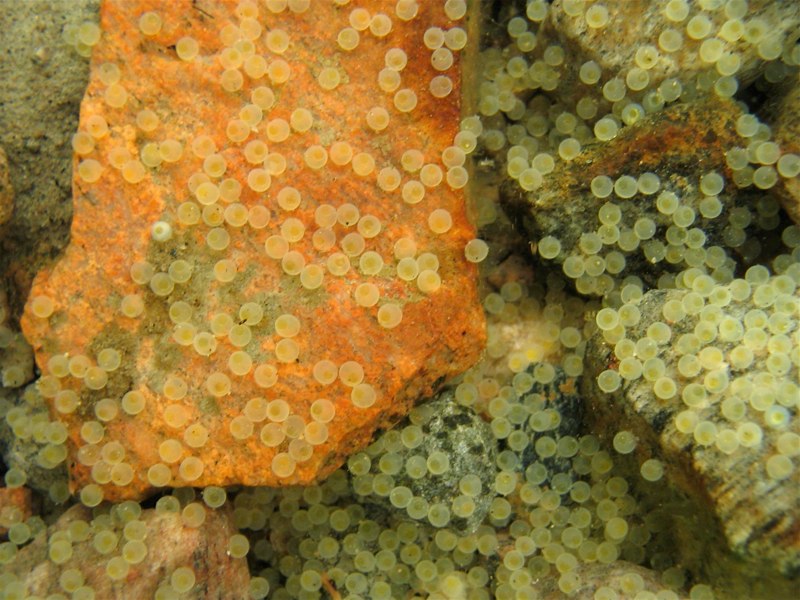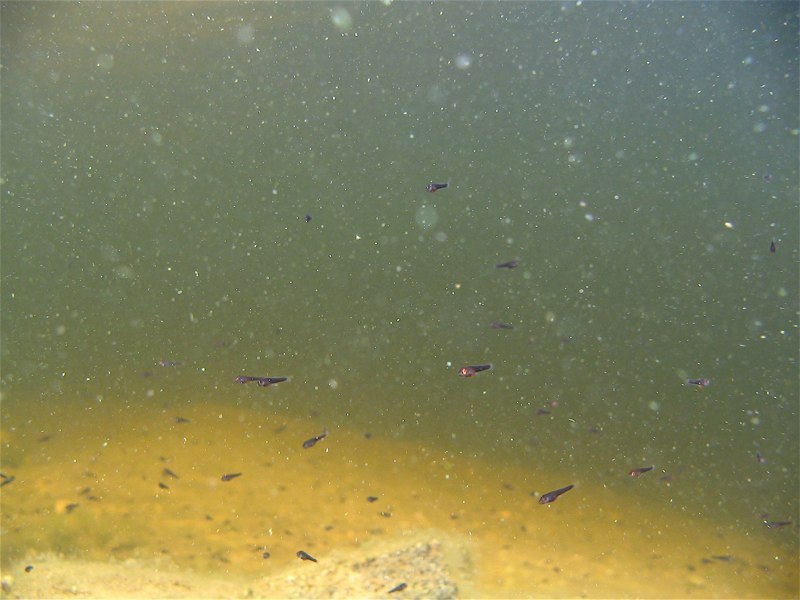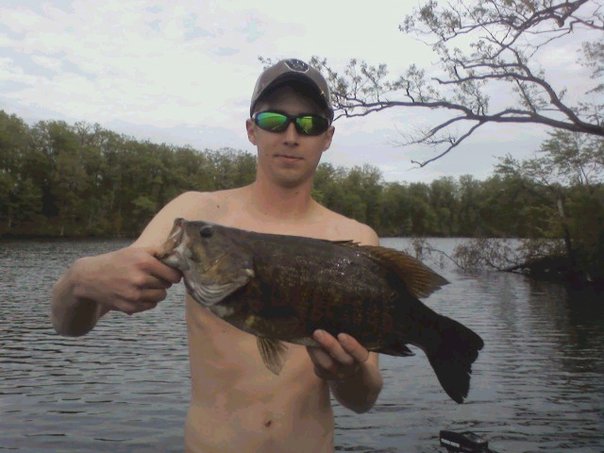SMALLMOUTH BASS
(Micropterus dolomieui)
Dustin Hetke
BIO 203: Organismal Biology, UW-La Crosse
Reproduction: From spawn to brawn
Spawning is the way by which smallmouth bass reproduce to bear a
substantial number of offspring. The smallmouth is a dioecious animal,
with separate male and female individuals. The fusion of
meiotically-produced haploid gametes, those being sperm from a
male and eggs from a female, leads to the formation of diploid
zygotes. Through various stages of ontogeny, which include
mitotic growth and differentiation of specialized cell types and
tissues, a fully-functional smallmouth bass eventually comes to
be. In Wisconsin, the average size of adult smallmouth
falls is between 12-20 inches and about one to four pounds.
However, as you may already know, this is incredibly variable
across different habitats and climate
regions that influence the smallmouth's
metabolism; it also depends on the genetic potential of a
particular specimen and whether or not it benefits from an
abundant prey supply at certain
times throughout the year. The Wisconsin state record
weighed 9 lb. 1 oz.; it was caught on Indian Lake in 1950.
The world-record smallmouth weighed 11 lb. 15 oz.; it was caught
in 1955 on Dale Hollow Reservoir in Tennessee. In general,
largemouth bass have a much greater overall growth capacity,
with the long-standing world record weighing in at 22 lbs. 4 oz.
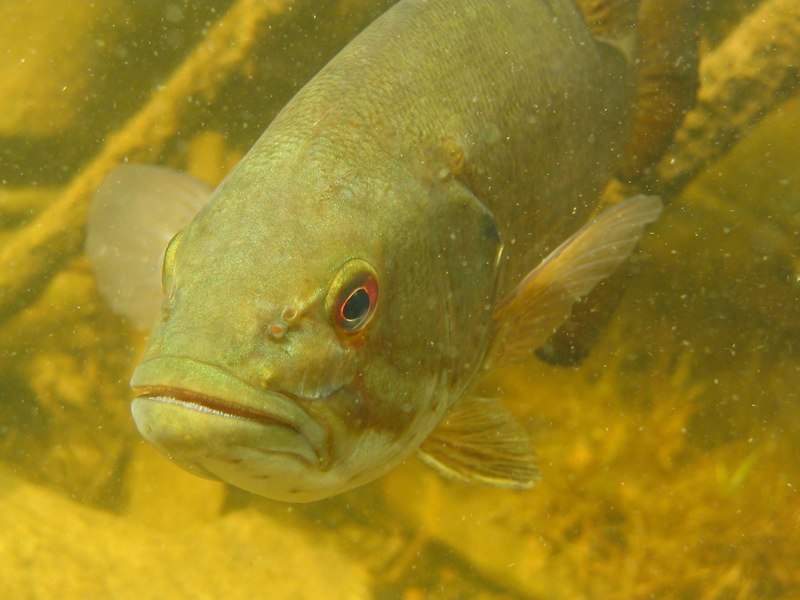 The timing by which smallmouth bass spawn is dictated almost entirely by
water
The timing by which smallmouth bass spawn is dictated almost entirely by
water
temperature. The onset of spring brings
increasing day
lengths, and therefore more
exposure to sunlight that brings warmth.
Weather, light intensity, and moon phases
are also thought to be
somewhat influential.
When water temperatures reach about
59-65oF,
conditions are found to be
conducive for nest-building and spawning
activity. In Wisconsin, this usually happens
within the months of
May and June, although
this temperature threshold is usually
reached at
different times from one body of
water to the next. Furthermore,
all of the
bass in a given water body do not spawn simultaneously;
usually, the largest and eldest specimens spawn first. The
spawning season is physically exhausting. Therefore, in
preparation, smallmouth feed heavily and aggressively during the
pre-spawn period to fatten up and store as much energy as possible.
When spawning temperatures arise, the male bass transitions out of
feeding mode and makes his way to the shallows to begin building a nest.
The male, as is the case for members of the sunfish
family, has many vital responsibilities associated with the spawning
process.
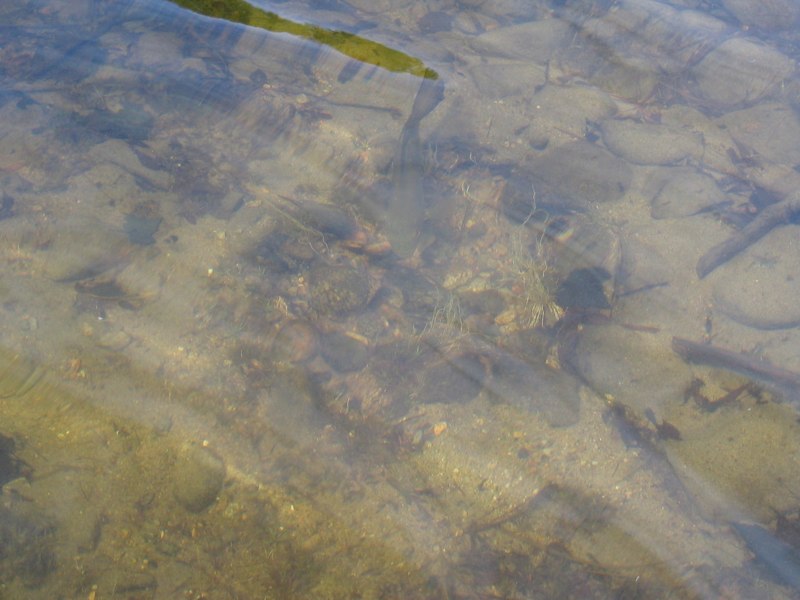 His to-do list includes building a nest that
is suitable and attractive for a
His to-do list includes building a nest that
is suitable and attractive for a
roe-laden (full-of-eggs) female;
fertilizing the eggs with his milt, which contains sperm; and protecting the bed full
of embryos and newly-hatched fry from intruders.
Gravel, bedrock, sand, and other hard-bottom surfaces with a relatively
flat elevation typically provide for popular nesting sites.
The male tends to select a nesting site that is relatively
sheltered or protected from strong winds or forceful water currents, in
shallow water that ranges from about three to ten feet in depth.
Upon deeming a location worthy, the male more or less uses his
tail like a broom, sweeping out a nest by brushing his caudal fin back
and forth across the lake floor. This displacement of
lake-bottom sediments leads to the formation of a semi-circular, concave
bed, with a diameter between two and four feet across.
Obtuse stones or other foreign objects are picked up and removed
from the nest by mouth. The process of nest
preparation can take anywhere from a few hours to two days for the male
to complete.
Upon building a spawning bed, the male anxiously hovers over the product of his work, awaiting the arrival of an egg-bearing female to capitalize on his efforts. During their courtship, they are known to show very vibrant and temporary changes in the intensity of their body colors, particularly in the male trying to win the female’s favor. If other envious smallmouth attempt to disrupt or intervene with this courtship, the male wastes no time in driving them away; if the female seems to have a change of heart and attempts to leave, he wastes no time in pushing her back over the bed. Next, the female drops to the bottom of the bed to disperse her many eggs, as the male assumes a slightly higher position at his mate’s side. As is the case for the vast majority of fish, the smallmouth bass is an oviparous creature, yielding offspring that hatch and develop from eggs which are fertilized outside the mother’s body. In intervals of under 30 seconds, the female emits up to 50 eggs at a time. The male, in turn, emits milt (containing sperm) over the eggs for fertilization. Anywhere from 2,000 to 14,000 eggs are eventually deposited onto the bed, usually depending on the size and age of the female.
When all of her ripened eggs have been laid, the female immediately
departs; if any eggs are retained, she may later spawn with another male
at another site. In a similar fashion, if the male has not run out
of milt, he may seduce another female and repeat the spawning process
again until he goes dry. When her egg supply is exhausted, the
female smallmouth returns to deeper water for much-needed rest.
Smallmouth bass are not lifelong mates; they are genetically programmed
for one-day stands, although nothing keeps them from catching up with
old acquaintances in future spawning seasons.
Still, the father’s work is far from complete after the female’s
departure. He must assume the important role of keeping
trespassers away from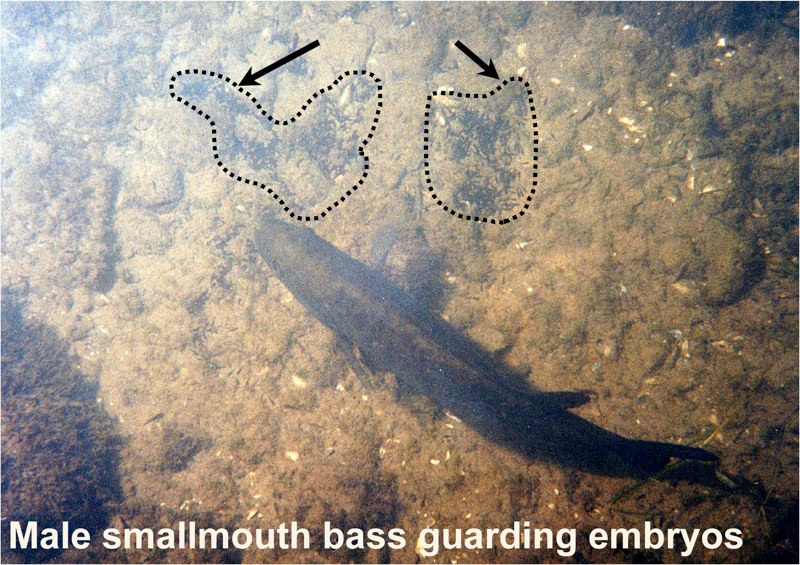 his progeny. For a brief period of time,
these embryos are susceptible to abrupt fluctuations in water
temperature, smothering from excess siltation, and infection; there is
little the male can do about these things, although he does periodically
fan the nest with his tail to freshen it up and promote oxygenation.
However, the highlight of the male’s protective behavior involves him
fending off any opportunistic predators that might be looking to rob
embryos, and later young fry, from his nest. With their high
protein content, embryonic smallmouth are of great nutritional appeal to
numerous other members of the food web. Spawning beds are often
found beside sunken logs or boulders, which can provide a physical
barrier against nest thieves and eliminate some of the area that the
bass must pay attention to. See
Interspecies relationship dynamics for further details concerning the antagonist
relationship between smallmouth bass and various examples of nest raiders.
his progeny. For a brief period of time,
these embryos are susceptible to abrupt fluctuations in water
temperature, smothering from excess siltation, and infection; there is
little the male can do about these things, although he does periodically
fan the nest with his tail to freshen it up and promote oxygenation.
However, the highlight of the male’s protective behavior involves him
fending off any opportunistic predators that might be looking to rob
embryos, and later young fry, from his nest. With their high
protein content, embryonic smallmouth are of great nutritional appeal to
numerous other members of the food web. Spawning beds are often
found beside sunken logs or boulders, which can provide a physical
barrier against nest thieves and eliminate some of the area that the
bass must pay attention to. See
Interspecies relationship dynamics for further details concerning the antagonist
relationship between smallmouth bass and various examples of nest raiders.
By the time a developing smallmouth hatches, it is completely colorless, only five millimeters long, and entirely reliant upon yolk for nourishment. In a matter of days, the hatchlings show pigmentation, followed by the development of all external features. Next, the young fry begin to congregate in schools. Upon learning how to feed for themselves, the young fry eventually grow confident enough to leave the school behind and venture out into the unknown. The father guards his fry only so long as necessary, which is usually between a few weeks and a month. Before long, the young fry disperse (as shown below) and abandon the relatively safe and familiar confines of shallow water structure.
By this time, family loyalty dissipates, leaving the young smallmouth subject to the unforgiving reality of the “big fish eat small fish” hierarchy. From this point on, it’s survival of the fittest; the young smallmouth bass can no longer trust its parents, siblings, or any fish of greater size with the inherent need to feed. One day, those young bass which endure the rigors of natural selection may be fortunate enough to reach sexual maturity and spawn offspring of their own. In reality, less than one percent of the offspring from a given spawning period actually reach this age, even when circumstances are favorable. Depending on environmental conditions, which can affect the rate of sexual development, sexual maturity is reached in anywhere from two to seven years; females, as a general rule, take a year or two longer than males. Eventually, the fully-grown smallmouth bass will become an essential living component of its ecosystem, and in many cases, a top-flight predator. The typical life duration of the smallmouth bass is 6-15 years, with a maximum life expectancy of about 18 years. As described on the Diet & metabolism page, growth rate and life expectancy are intimately correlated with climate and metabolism.
This smallmouth (above), pushing 20 inches in length and 5 lbs. in weight, has undoubtedly attained a trophy size and prowess that makes it a top-level predator within Long Lake, Chippewa County, Wisconsin. Based on the seasonal climate and limited growth rate of smallmouth in this area, this beautiful fish exemplifies the benefits of patiently waiting for the smallmouth to fulfill its life potential; the fish above is probably well over 10 years old. Thanks to the catch-photo-release practices of bass fisherman like my friend Jake, this fish is still alive and passing its genes on to future smallmouth generations.
If you wish, proceed to learn about some of the ways that smallmouth bass interact with other organisms within their dynamic freshwater ecosystems.
(Return to home page)
